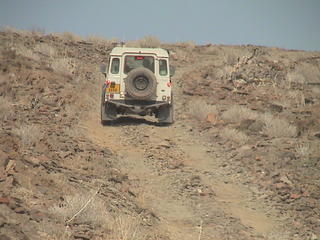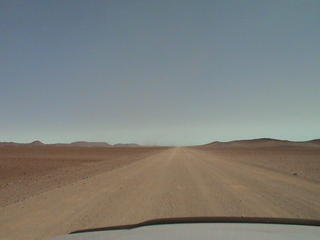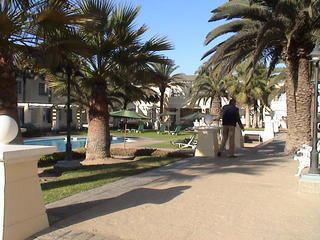As I said yesterday the tour is now heading almost due south and today's drive took us along wonderful fast straight tarmac and gravel roads to the Atlantic coast of Namibia and then to our hotel in Swakopmund.
There were two route options in the road book. The first was for those who wanted to tackle a difficult 4 x 4 section of mountain track and the second taking mainly tarmac roads through the Namib Desert to Swakopmund. We decided it was time to tackle a good 4 x 4 route as we had, up to now, opted to either take the main roads or to go on a different route altogether.
We set off at six o'clock on more of these incredibly straight Namibian roads. It will be very difficult getting used to the UK roads after Namibia! After about 150 kms we took the first section of gravel road to see an impressive rock formation called Finger Rock. This massive column of rock, created by wind and water erosion, stands hundreds of feet above the surrounding countryside.
There were two route options in the road book. The first was for those who wanted to tackle a difficult 4 x 4 section of mountain track and the second taking mainly tarmac roads through the Namib Desert to Swakopmund. We decided it was time to tackle a good 4 x 4 route as we had, up to now, opted to either take the main roads or to go on a different route altogether.
We set off at six o'clock on more of these incredibly straight Namibian roads. It will be very difficult getting used to the UK roads after Namibia! After about 150 kms we took the first section of gravel road to see an impressive rock formation called Finger Rock. This massive column of rock, created by wind and water erosion, stands hundreds of feet above the surrounding countryside.
Finger Rock, Namibia
The area here was very reminiscent of Monument Valley in the USA, with great flat topped mountains.
A bit about driving on gravel roads. On these roads the dust thrown up by a car is quite unbelievable. It is extremely difficult to pass a slower car, as you are driving 'blind' when you are about to overtake. It makes for very tiring driving. The dust gets everywhere and no matter how hard you try to stop it getting in to the car a fine layer soon settles over everything.
A bit about driving on gravel roads. On these roads the dust thrown up by a car is quite unbelievable. It is extremely difficult to pass a slower car, as you are driving 'blind' when you are about to overtake. It makes for very tiring driving. The dust gets everywhere and no matter how hard you try to stop it getting in to the car a fine layer soon settles over everything.
The further I go without the car suffering any mechanical failures the more concerned I become that something might go wrong. So, when we started the rough 4 x 4 section I began to worry this might be the day the car would let us down. I shouldn't have worried. Even though the going was extremely tough with deep ruts, boulders all over the place and steep uphill sections of track, the car once again proved how tough it is.

Jean Steinhauser and Anne Collard in their Landrover Defender on a very steep section of track
Once through the 68 kms of rough track we flew down the 75 kms to the sea. We were now in the magnificent Namib Desert, one of the driest places in the world.

The magnificent wilderness of the Namib Desert

Long straight roads leading to the Atlantic coast of Namibia. Not a sign of life anywhere!
About halfway we stopped at Cape Cross seal colony, where apparently an estimated 100,000 to 200,000 grey seals live. It is an incredible sight to see so many crowded together on the beach. The noise they make is quite astonishing, as is the smell!

Cape Cross Seal Reserve on the Atlantic coast

Swakopmund Hotel, a converted railway station
No comments:
Post a Comment